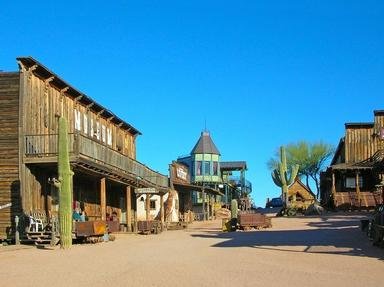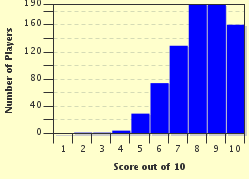Quiz Answer Key and Fun Facts
1. Let's start with an easy one. I was born in Kearney, Missouri in 1847. Along with my brother, Frank, I served in the Confederate army during the Civil War, during which I was wounded. After the war, I joined a gang that became famous for robbing banks and trains. I died in 1882, when I was shot in the back of the head while standing on a chair to straighten a picture. Who am I?
2. I was born in New York City around 1859. My family moved to New Mexico when I was 14, and by the age of 15 I was arrested for the first time. I killed my first man before I reached the age of 18. In 1877, I became involved in the Lincoln County War. I was sentenced to be hanged in 1881, but escaped from jail, killing two guards in the process. I was soon hunted down and killed by Sheriff Pat Garrett. My birth name was William Henry McCarty, Jr., but I am better known by my nickname. Who am I?
3. Although I am associated with American Wild West, I was actually born in Canada. I made my living as a gambler and a lawman. Later in life I moved to New York City, and made my living writing for a newspaper. Unlike many of my contemporaries, I lived a full life, dying of natural causes at the age of 67. A television series starring Gene Barry was named after me. Who am I?
4. I was born in Illinois in 1848. Like many Wild West characters I led a checkered life, being among other things a gambler, saloon keeper and miner. I was once arrested for being a pimp and the keeper of a "house of ill-fame." But today I am remembered as a lawman. With my brothers, Morgan and Virgil, I took part in a famous gunfight at the O.K. Corral in Tombstone, Arizona. Who am I?
5. I was born in Texas in 1853. I may be the most psychopathic of all these characters. By my own account, I killed 44 men by the age of 23. Legend says I once shot and killed a man for snoring. The law caught up with me in 1875, and I spent 17 years in prison. Less than two years after my release, a man named John Selman walked up behind me in an El Paso saloon and shot me in the head. Bob Dylan named an album after me, but misspelled my name. I would probably have shot him for that. Who am I?
6. I may not be as famous as some of these other guys, but that doesn't mean I wasn't a man to be reckoned with. I was born in Indiana in 1851, but moved to Texas while still in my teens. I acquired a racehorse called "the Denton Mare," and soon began making my living as a gambler. In 1875 I joined a cattle drive that took me to the Dakota Territory, and soon formed a gang known as "the Black Hills Bandits." My most famous exploit was robbing a Union-Pacific Train of $60,000 in gold in 1877. Although both the Pinkertons and the Texas Rangers were after me, I eluded capture until one of my own gang betrayed me. I was wounded in a shootout with the Texas Rangers in Round Rock, Texas on July 19, 1878 and died two days later, on my twenty-seventh birthday. Despite my life of crime, some people in Texas still regard me as a heroic figure. Who am I?
7. I was born in England in 1843, but moved to Texas along with my parents at the age of eight. I killed my first man at the age of 17 in a gambling fight. After following a career as a gambler and saloon owner, I was appointed the City Marshall for Austin, Texas but had to resign a year later after killing a man in a gunfight. I was killed in a theatre in San Antonio in 1884. I was famous for my lightning fast draw. Who am I?
8. I was born in Illinois in 1837. After serving as a stock tender for the Pony Express and a brief stint in the Union army during the Civil War, I devoted the remainder of my life to gambling and law enforcement. I was famous for my long, flowing hair and my marksmanship. In 1876, I was playing poker in Deadwood, South Dakota when a man named Jack McCall snuck up behind me and shot me in the head. The hand I was holding when I was shot was two black aces and two black eights. Who am I?
9. I was born in Georgia in 1851. I was trained as a dentist, and followed that trade, on and off, for much of my life, but my primary vocation was gambling. I was a friend of Wyatt Earp, and had a common law wife known as Big Nose Kate. I suffered from tuberculosis all of my adult life, and died of the disease in Glenwood, Colorado in 1887. Who am I?
10. I was born in England in 1829, but went to America when I was only two years old. While others robbed banks and railroads, my specialty was robbing stagecoaches. I am best remembered for my habit of leaving poems at the scene of my crimes. I was eventually caught and served four years in prison. After my release, I disappeared from history. Who am I?
Source: Author
daver852
This quiz was reviewed by FunTrivia editor
bloomsby before going online.
Any errors found in FunTrivia content are routinely corrected through our feedback system.

